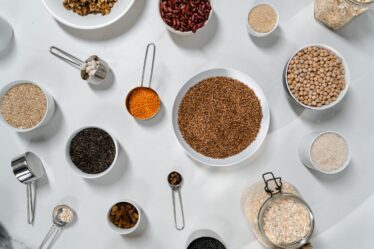
Dry chili flakes, also known as crushed red pepper flakes, are a popular spice used in many cuisines around the world. They are made from dried chili peppers that have been crushed or ground into small flakes. These flakes are known for their fiery heat and intense flavor, making them a staple in spicy dishes.
The history of chili flakes dates back thousands of years. Chili peppers were first cultivated in Central and South America and were later introduced to Europe by Christopher Columbus. Since then, chili peppers have become a key ingredient in many global cuisines, including Mexican, Indian, Thai, and Korean.
Chili flakes are commonly used to add heat and flavor to a variety of dishes. They can be sprinkled on top of pizzas, pasta dishes, soups, stews, and even desserts. They can also be used as a seasoning for meats, vegetables, and sauces. The versatility of chili flakes makes them a must-have spice in any kitchen.
Key Takeaways
- Dry chili flakes are small pieces of dried chili peppers that can add heat and flavor to dishes.
- Adding dry chili flakes to your diet can provide health benefits such as boosting metabolism and reducing inflammation.
- When choosing dry chili flakes, consider the level of heat and flavor you want and the type of cuisine you are cooking.
- Dry chili flakes can be incorporated into dishes in various ways, such as sprinkling on top or infusing into oils and sauces.
- Dry chili flakes are spicier than fresh chili peppers due to the concentration of capsaicin, the compound responsible for heat.
The Health Benefits of Adding Dry Chili Flakes to Your Diet
In addition to their fiery flavor, dry chili flakes also offer several health benefits. They are rich in vitamins A and C, as well as minerals like potassium and iron. These nutrients are essential for maintaining a healthy immune system and promoting overall well-being.
One of the key compounds found in chili flakes is capsaicin. Capsaicin is responsible for the spicy sensation that chili peppers produce. It has been shown to have numerous health benefits, including pain relief, improved digestion, and increased metabolism. Capsaicin has also been found to have anti-inflammatory properties and may help reduce the risk of certain chronic diseases.
In addition to capsaicin, chili flakes contain antioxidants that help protect the body against free radicals and oxidative stress. These antioxidants have been linked to a reduced risk of heart disease, cancer, and other chronic conditions. Incorporating chili flakes into your diet can be a flavorful way to boost your overall health.
How to Choose the Right Type of Dry Chili Flakes for Your Dishes
When it comes to choosing the right type of dry chili flakes for your dishes, there are several factors to consider. Different types of chili flakes have varying levels of heat and flavor profiles, so it’s important to choose one that suits your taste preferences and the dish you’re preparing.
There are many different types of chili flakes available, ranging from mild to extremely hot. Some popular varieties include cayenne, Aleppo, ancho, and Korean gochugaru. Cayenne pepper flakes are known for their medium heat and versatile flavor, making them a great all-purpose option. Aleppo pepper flakes have a slightly fruity and smoky flavor with a moderate level of heat. Ancho pepper flakes are made from dried poblano peppers and have a mild, sweet flavor. Gochugaru is a Korean chili flake that is known for its vibrant red color and medium heat.
When choosing chili flakes, it’s important to consider the flavor profile you’re looking for. Some chili flakes have a smoky or fruity flavor, while others are more earthy or spicy. Consider the dish you’re preparing and choose a chili flake that complements the other ingredients.
The Different Ways to Incorporate Dry Chili Flakes into Your Cooking
| Ways to Incorporate Dry Chili Flakes into Your Cooking | Description |
|---|---|
| Seasoning | Sprinkle dry chili flakes on top of your dishes to add a spicy kick. |
| Marinade | Add dry chili flakes to your marinade to infuse your meat with a spicy flavor. |
| Sauce | Make a spicy sauce by mixing dry chili flakes with other ingredients like tomato sauce, vinegar, and honey. |
| Infused Oil | Make your own chili oil by infusing olive oil with dry chili flakes. |
| Spice Blend | Create your own spice blend by mixing dry chili flakes with other spices like cumin, coriander, and paprika. |
There are countless ways to incorporate dry chili flakes into your cooking. They can be added to sauces and marinades, used as a seasoning for meats and vegetables, or even incorporated into baked goods and desserts.
One popular way to use chili flakes is by adding them to sauces and marinades. They can add a spicy kick to pasta sauces, stir-fry sauces, and barbecue marinades. Simply sprinkle the desired amount of chili flakes into the sauce or marinade and adjust according to your taste preferences.
Chili flakes can also be used as a seasoning for meats and vegetables. They can be sprinkled on top of grilled chicken, roasted vegetables, or even popcorn for an extra burst of flavor. Just be sure to use them sparingly, as they can be quite spicy.
Surprisingly, chili flakes can also be incorporated into baked goods and desserts. They can add a unique twist to chocolate desserts, such as brownies or cookies. Just be cautious when adding chili flakes to sweet dishes, as they can easily overpower the other flavors.
Dry Chili Flakes vs. Fresh Chili Peppers: Which is Better?
When it comes to choosing between dry chili flakes and fresh chili peppers, it ultimately comes down to personal preference and the dish you’re preparing. Both options have their own unique characteristics and can be used in different ways.
Dry chili flakes are convenient and easy to use. They have a long shelf life and can be stored for months without losing their flavor or spiciness. They are also more versatile than fresh chili peppers, as they can be easily sprinkled onto dishes or incorporated into sauces and marinades.
Fresh chili peppers, on the other hand, offer a different flavor profile and texture. They have a crisp and juicy texture that can add a refreshing element to dishes. Fresh chili peppers also have a more intense heat compared to chili flakes, so they can be used to add a fiery kick to dishes.
When deciding between dry chili flakes and fresh chili peppers, consider the flavor profile you’re looking for and the level of heat you want to achieve. If you prefer a milder heat and more convenience, dry chili flakes may be the better option. However, if you enjoy the freshness and intensity of fresh chili peppers, they can be a great addition to your dishes.
The Science Behind the Spiciness of Dry Chili Flakes

The spiciness of dry chili flakes is due to a compound called capsaicin. Capsaicin is found in the white pith and seeds of chili peppers and is responsible for the burning sensation that occurs when you consume spicy foods.
When capsaicin comes into contact with the tongue or other mucous membranes, it binds to pain receptors called TRPV1 receptors. This binding triggers a response in the body, causing a burning sensation and releasing endorphins, which are natural painkillers.
The spiciness of chili flakes can vary depending on the type of chili pepper used and the amount of capsaicin present. The Scoville scale is used to measure the spiciness of chili peppers and chili flakes. It ranges from 0 (no heat) to over 2 million (extremely hot). For example, cayenne pepper flakes typically range from 30,000 to 50,000 Scoville Heat Units (SHU), while ghost pepper flakes can reach up to 1 million SHU.
Several factors can affect the spiciness of chili flakes, including the variety of chili pepper used, the growing conditions, and how the peppers are processed. It’s important to keep this in mind when using chili flakes in your cooking, as different varieties can vary significantly in heat level.
Tips for Storing and Preserving Dry Chili Flakes
To ensure that your dry chili flakes retain their flavor and spiciness, it’s important to store them properly. Here are some tips for storing and preserving your chili flakes:
– Store in an airtight container: Transfer your chili flakes to an airtight container, such as a glass jar or plastic bag. This will help prevent moisture from getting in and keep your chili flakes fresh.
– Keep away from heat and light: Store your chili flakes in a cool, dark place, such as a pantry or cupboard. Exposure to heat and light can cause the flavor and spiciness to deteriorate.
– Avoid storing near strong odors: Chili flakes can absorb odors from other spices, so it’s best to store them away from strong-smelling spices like garlic or cumin.
– Use a spice grinder: If you prefer a finer texture, you can grind your chili flakes using a spice grinder or mortar and pestle. This will release more of the flavor and heat from the chili flakes.
– Check for freshness: Over time, chili flakes can lose their flavor and spiciness. It’s a good idea to check the expiration date on the packaging and replace your chili flakes if they are past their prime.
With proper storage, dry chili flakes can be kept for up to a year without losing their flavor or spiciness. However, it’s best to use them within six months for optimal taste.
The Best Dishes to Spice Up with Dry Chili Flakes
Dry chili flakes can add a fiery kick to a wide range of dishes. Here are some examples of dishes that can be enhanced with chili flakes:
– Pasta dishes: Sprinkle chili flakes on top of spaghetti aglio e olio, arrabbiata sauce, or carbonara for an extra burst of heat.
– Pizza: Add chili flakes to your favorite pizza toppings for a spicy twist. They pair well with pepperoni, sausage, and vegetables.
– Soups and stews: Stir chili flakes into chili con carne, lentil soup, or vegetable curry for added heat and flavor.
– Grilled meats: Rub chili flakes onto chicken, steak, or pork before grilling for a spicy marinade.
– Roasted vegetables: Toss vegetables like Brussels sprouts, cauliflower, or sweet potatoes with olive oil and chili flakes before roasting for a flavorful side dish.
– Chocolate desserts: Add a pinch of chili flakes to brownie batter or chocolate ganache for a unique and spicy twist.
Chili flakes can be used in a variety of cuisines, including Mexican, Indian, Thai, and Korean. They pair well with ingredients like garlic, onions, tomatoes, and citrus fruits. Don’t be afraid to experiment with different flavor combinations and find your own favorite dishes to spice up with chili flakes.
How to Balance the Heat of Dry Chili Flakes with Other Flavors
If you find that chili flakes are too spicy for your taste, there are several techniques and ingredients you can use to balance the heat. Here are some tips for toning down the spiciness of chili flakes:
– Use dairy products: Dairy products like yogurt, sour cream, or cheese can help neutralize the heat of chili flakes. Add a dollop of yogurt or sprinkle some cheese on top of a spicy dish to mellow out the spiciness.
– Add sweetness: Sweet ingredients like honey, sugar, or maple syrup can help counteract the heat of chili flakes. Add a touch of sweetness to your dish to balance out the spiciness.
– Use acid: Acidic ingredients like lemon juice or vinegar can help cut through the heat of chili flakes. Squeeze some lemon juice over a spicy dish or add a splash of vinegar to balance out the flavors.
– Increase the other flavors: By adding more of the other ingredients in your dish, you can dilute the spiciness of chili flakes. Increase the amount of vegetables, meat, or sauce in your recipe to balance out the heat.
It’s important to note that adjusting the amount of chili flakes in a recipe can also help control the spiciness. Start with a small amount and gradually increase until you reach your desired level of heat.
Creative Recipes to Try with Dry Chili Flakes
If you’re looking for some creative ways to incorporate dry chili flakes into your cooking, here are a few recipes to try:
1. Spicy Honey-Glazed Chicken Wings:
– In a bowl, mix together honey, soy sauce, garlic, ginger, and chili flakes.
– Toss chicken wings in the marinade and let them marinate for at least 30 minutes.
– Preheat the oven to 400°F (200°C) and line a baking sheet with parchment paper.
– Place the marinated chicken wings on the baking sheet and bake for 25-30 minutes, or until cooked through and crispy.
– Serve the chicken wings with a sprinkle of chili flakes for an extra kick.
2. Spicy Shrimp Stir-Fry:
– Heat oil in a wok or large skillet over high heat.
– Add shrimp and stir-fry for 2-3 minutes, or until pink and cooked through.
– Remove the shrimp from the pan and set aside.
– In the same pan, add garlic, ginger, bell peppers, and chili flakes. Stir-fry for 2-3 minutes, or until the vegetables are tender-crisp.
– Return the shrimp to the pan and add soy sauce, honey, and lime juice. Stir-fry for another minute to coat the shrimp and vegetables in the sauce.
– Serve the spicy shrimp stir-fry over steamed rice and garnish with chopped cilantro and extra chili flakes.
3. Spicy Chocolate Brownies:
– Preheat the oven to 350°F (175°C) and line a baking dish with parchment paper.
– In a microwave-safe bowl, melt butter and chocolate together in 30-second intervals until smooth.
– In a separate bowl, whisk together sugar, eggs, vanilla extract, and chili flakes.
– Gradually add the melted chocolate mixture to the egg mixture, stirring until well combined.
– Sift in flour and cocoa powder and fold until just combined.
– Pour the batter into the prepared baking dish and smooth the top.
– Bake for 25-30 minutes, or until a toothpick inserted into the center comes out with a few moist crumbs.
– Let the brownies cool completely before cutting into squares and serving.
These recipes are just a starting point for incorporating dry chili flakes into your cooking. Feel free to experiment and adjust the amount of chili flakes to suit your taste preferences. Whether you’re looking to add a spicy kick to your favorite dishes or explore new flavor combinations, dry chili flakes are a versatile and exciting spice to have in your kitchen.
If you’re a fan of adding a little heat to your dishes, then you’ll love this article on Flavorful Sips about how to make your own dry chili flakes at home. It’s a great way to add a spicy kick to your favorite recipes. Check out the article here for step-by-step instructions and tips on mastering the art of dry chili flakes.



